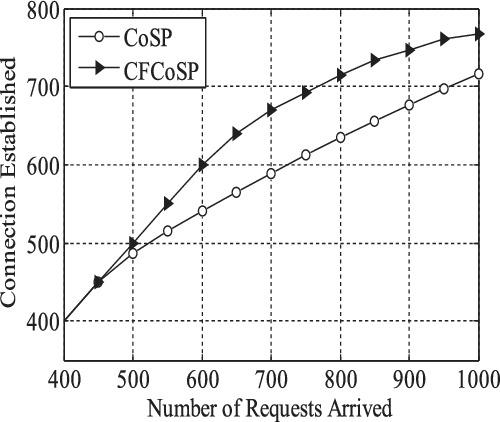当前位置:
X-MOL 学术
›
Int. J. Commun. Syst.
›
论文详情
Our official English website, www.x-mol.net, welcomes your
feedback! (Note: you will need to create a separate account there.)
Cost function‐based class of service provisioning strategy in elastic optical networks
International Journal of Communication Systems ( IF 1.7 ) Pub Date : 2020-10-11 , DOI: 10.1002/dac.4634 Shruti Dixit 1 , Deepak Batham 1 , Ravindra Pratap Narwaria 1
International Journal of Communication Systems ( IF 1.7 ) Pub Date : 2020-10-11 , DOI: 10.1002/dac.4634 Shruti Dixit 1 , Deepak Batham 1 , Ravindra Pratap Narwaria 1
Affiliation

|
The recent fog‐and‐cloud computing, Internet of things (IoT), artificial intelligence, machine learning, and store‐and‐forward datacenter applications gradually increase the Internet traffic. The arrival of this traffic is periodic, which remains high during certain time duration (known as peak or working/office hour) each day, resulting in an increase in the resource bottleneck problem, which causes high connections blocking. Due to these, many commercial and business data services may lose their connections which contain the urgent and important information. In order to handle such a critical situation in elastic optical networks (EONs), prioritization of connection requests based on the differentiated class of service (CoS) is a must. In this paper, the network traffic is categorized into three CoS requests. These are CoS1 (real‐time traffic), CoS2 (nonreal‐time traffic), and CoS3 (delay‐tolerant traffic) and proposed a cost function‐based CoS provisioning (CFCoSP) strategy in which the connection requests are served as per an increasing value of cost function. The cost function is a cumulative function of CoS, pathlength, and requested bandwidth demand (i.e., number of frequency slots required). The simulations are performed on INDIAN and ARPANET network topologies under uniform CoS ratio (i.e., CoS1:CoS2:CoS3 = 1:1:1) on the metrics of connection established, bandwidth blocking probability, resource utilization ratio, and network capacity utilization. The simulation results verify that the proposed CFCoSP strategy shows significantly improved performances as compared to an existing non‐cost CoS provisioning (CoSP) strategy on the investigated metrics.
中文翻译:

弹性光网络中基于成本函数的服务分类策略
最近的雾云计算,物联网(IoT),人工智能,机器学习以及存储转发数据中心应用程序逐渐增加了Internet流量。此流量的到达是周期性的,在每天的特定时间段(称为高峰或工作/办公时间)内保持较高状态,从而导致资源瓶颈问题增加,从而导致高连接阻塞。因此,许多商业和商业数据服务可能会失去包含紧急和重要信息的连接。为了处理弹性光网络(EON)中的这种紧急情况,必须基于区分服务等级(CoS)区分连接请求的优先级。本文将网络流量分为三个CoS请求。这些是CoS1(实时流量),CoS2(非实时流量)和CoS3(延迟容忍流量),并提出了一种基于成本函数的CoS设置(CFCoSP)策略,其中,连接请求根据成本函数的价值增长而得到满足。成本函数是CoS,路径长度和请求的带宽需求(即,所需的频槽数量)的累积函数。在建立连接,带宽阻塞概率,资源利用率和网络容量利用率的度量标准下,在统一CoS比(即CoS1:CoS2:CoS3 = 1:1:1)下对INDIAN和ARPANET网络拓扑进行仿真。仿真结果证明,与现有的基于调查指标的非成本CoS设置(CoSP)策略相比,所提出的CFCoSP策略具有显着改善的性能。以及CoS3(延迟容忍流量),并提出了一种基于成本函数的CoS设置(CFCoSP)策略,其中,根据成本函数的增值来满足连接请求。成本函数是CoS,路径长度和请求的带宽需求(即,所需的频槽数量)的累积函数。在建立连接,带宽阻塞概率,资源利用率和网络容量利用率的度量标准下,在统一CoS比(即CoS1:CoS2:CoS3 = 1:1:1)下对INDIAN和ARPANET网络拓扑进行仿真。仿真结果证明,与现有的基于调查指标的非成本CoS设置(CoSP)策略相比,所提出的CFCoSP策略具有显着改善的性能。以及CoS3(延迟容忍流量),并提出了一种基于成本函数的CoS设置(CFCoSP)策略,其中,根据成本函数的增值来满足连接请求。成本函数是CoS,路径长度和请求的带宽需求(即,所需的频槽数量)的累积函数。在建立连接,带宽阻塞概率,资源利用率和网络容量利用率的度量标准下,在统一CoS比(即CoS1:CoS2:CoS3 = 1:1:1)下对INDIAN和ARPANET网络拓扑进行仿真。仿真结果证明,与现有的基于调查指标的非成本CoS设置(CoSP)策略相比,所提出的CFCoSP策略具有显着改善的性能。
更新日期:2020-11-09
中文翻译:

弹性光网络中基于成本函数的服务分类策略
最近的雾云计算,物联网(IoT),人工智能,机器学习以及存储转发数据中心应用程序逐渐增加了Internet流量。此流量的到达是周期性的,在每天的特定时间段(称为高峰或工作/办公时间)内保持较高状态,从而导致资源瓶颈问题增加,从而导致高连接阻塞。因此,许多商业和商业数据服务可能会失去包含紧急和重要信息的连接。为了处理弹性光网络(EON)中的这种紧急情况,必须基于区分服务等级(CoS)区分连接请求的优先级。本文将网络流量分为三个CoS请求。这些是CoS1(实时流量),CoS2(非实时流量)和CoS3(延迟容忍流量),并提出了一种基于成本函数的CoS设置(CFCoSP)策略,其中,连接请求根据成本函数的价值增长而得到满足。成本函数是CoS,路径长度和请求的带宽需求(即,所需的频槽数量)的累积函数。在建立连接,带宽阻塞概率,资源利用率和网络容量利用率的度量标准下,在统一CoS比(即CoS1:CoS2:CoS3 = 1:1:1)下对INDIAN和ARPANET网络拓扑进行仿真。仿真结果证明,与现有的基于调查指标的非成本CoS设置(CoSP)策略相比,所提出的CFCoSP策略具有显着改善的性能。以及CoS3(延迟容忍流量),并提出了一种基于成本函数的CoS设置(CFCoSP)策略,其中,根据成本函数的增值来满足连接请求。成本函数是CoS,路径长度和请求的带宽需求(即,所需的频槽数量)的累积函数。在建立连接,带宽阻塞概率,资源利用率和网络容量利用率的度量标准下,在统一CoS比(即CoS1:CoS2:CoS3 = 1:1:1)下对INDIAN和ARPANET网络拓扑进行仿真。仿真结果证明,与现有的基于调查指标的非成本CoS设置(CoSP)策略相比,所提出的CFCoSP策略具有显着改善的性能。以及CoS3(延迟容忍流量),并提出了一种基于成本函数的CoS设置(CFCoSP)策略,其中,根据成本函数的增值来满足连接请求。成本函数是CoS,路径长度和请求的带宽需求(即,所需的频槽数量)的累积函数。在建立连接,带宽阻塞概率,资源利用率和网络容量利用率的度量标准下,在统一CoS比(即CoS1:CoS2:CoS3 = 1:1:1)下对INDIAN和ARPANET网络拓扑进行仿真。仿真结果证明,与现有的基于调查指标的非成本CoS设置(CoSP)策略相比,所提出的CFCoSP策略具有显着改善的性能。











































 京公网安备 11010802027423号
京公网安备 11010802027423号